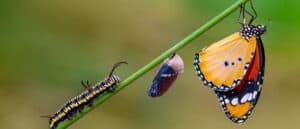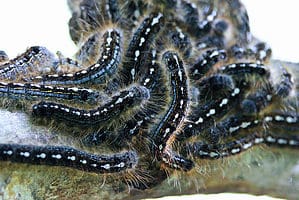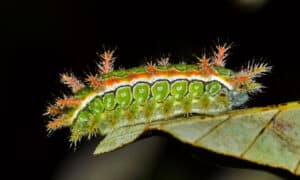The culture and natural landscape of Louisiana attract millions of visitors every year. This state’s Creole cuisine and diverse cultures all contribute to its beauty, but the wildlife and insects that populate it play an equally important role in its splendor. Hundreds of caterpillars are found in Louisiana and surrounding states, making their home amid mild winters, heavy rains, and intensely hot summers.
Caterpillars span the entire state, exploring woodlands, gardens, and more. While they look like small worms, they are drastically different. They metamorphose to become moths or butterflies, contributing to the incredible wildlife found in this rich state. Butterfly and moth caterpillars account for hundreds of insect species in the state. As beautiful as they are, you need to know which ones are the safest to be around before you spend time in your garden or local plants.
Caterpillars: Moths vs. Butterflies

While butterflies and moths are much different, both build cocoons as they transform from caterpillars to their adult form.
©Ksenia Ragozina/Shutterstock.com
The outstretched wings of a moth or a butterfly trick many people, but understanding the difference between these two insects makes a difference when seeking caterpillars. These caterpillars morph into unique and beautiful pictures with time, but there are a few distinct differences. As adults, moths tend to be much smaller, and butterflies feature large and beautifully colored wings. These size and color differences define that particular species easily, but what about their time as caterpillars?
The telltale sign is usually their hair. A caterpillar with smooth skin needs more details to differentiate them, but fuzzy or hairy skin means that the caterpillar’s fate is to become a moth. While a butterfly caterpillar has no hair, it might be spiky to protect itself from predators. Though spikes are more intimidating, moth caterpillars are more dangerous to you and are among Louisiana’s only poisonous caterpillars.
While several moth caterpillars are poisonous and quite dangerous, none of the butterfly caterpillars have the same danger. Still, these caterpillars feature spikes that provide an easy defense against predators. Moth caterpillars aren’t nearly as colorful as butterflies, but the Louisiana environments create an ideal opportunity for them to thrive. Still, knowing what to look out for makes the difference between a nice day outside and a trip to the doctor.
Dangerous Caterpillars
Dangerous: American Dagger Moth Caterpillar
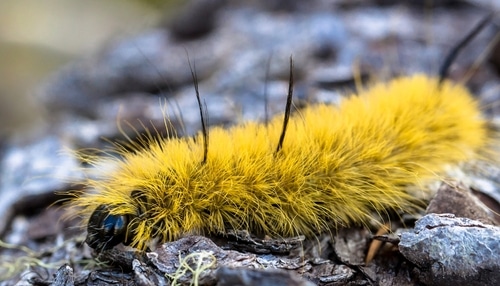
The American dagger moth is fairly common, but the hair leaves a dangerous and painful sensation behind.
©karan kiruba/Shutterstock.com
The American dagger moth caterpillar prefers the eastern side of the United States. Along with inhabiting woody areas of Louisiana, this caterpillar lives in any state east of Colorado. Since its diet consists of maple, oak, ash, willow, hickory, and similar trees, you must check local orchards or forests to find it. The primary diet includes maple and boxelder leaves, but it cuts the leaf off at the stem to bring it along.
With colorful yellow hairs along the entire body, it looks rather soft, but stay away! Even a slight graze of these hairs leaves them broken in the skin, leading to a burning sensation on the skin with hives and substantial irritation. Removing it gently with a stick is enough to keep it away from children’s play areas. This caterpillar eventually grows into the largest dagger moth at 2 inches in length.
Dangerous: Buck Moth Caterpillar
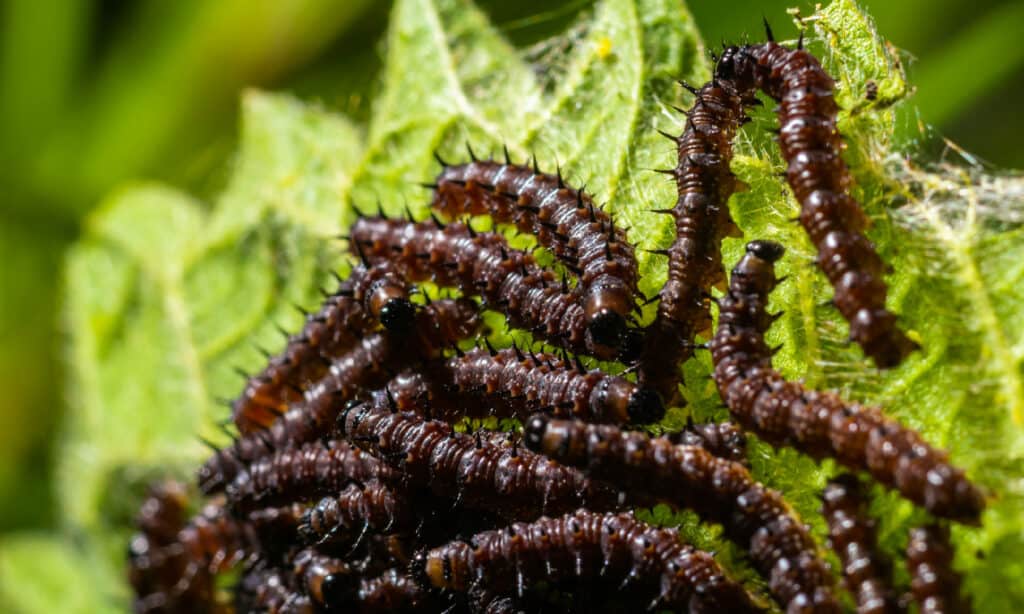
The buck moth caterpillar lives in oak trees along the eastern side of the United States.
©iStock.com/Oleg Marchak
The buck moth caterpillar generation is born annually, though finding them is easiest during the spring and early summer. They remain as caterpillars for up to two years before they become the adult buck moth, and they live as far south as Florida or as north as Maine. They prefer areas with oak trees, but their diet becomes more varied when they dine on willow trees, wild cherry trees, and rose bushes.
These large insects measure up to 2.4 inches long and have red-hued heads. Their body features white spots along their dark skin, and their spines connect to venom glands. If you sustain a sting, the onset of pain is quick, making your skin feel itchy, reddened, and swollen. The welts caused by the buck moth caterpillar last for up to a week.
Dangerous: Io Moth Caterpillar
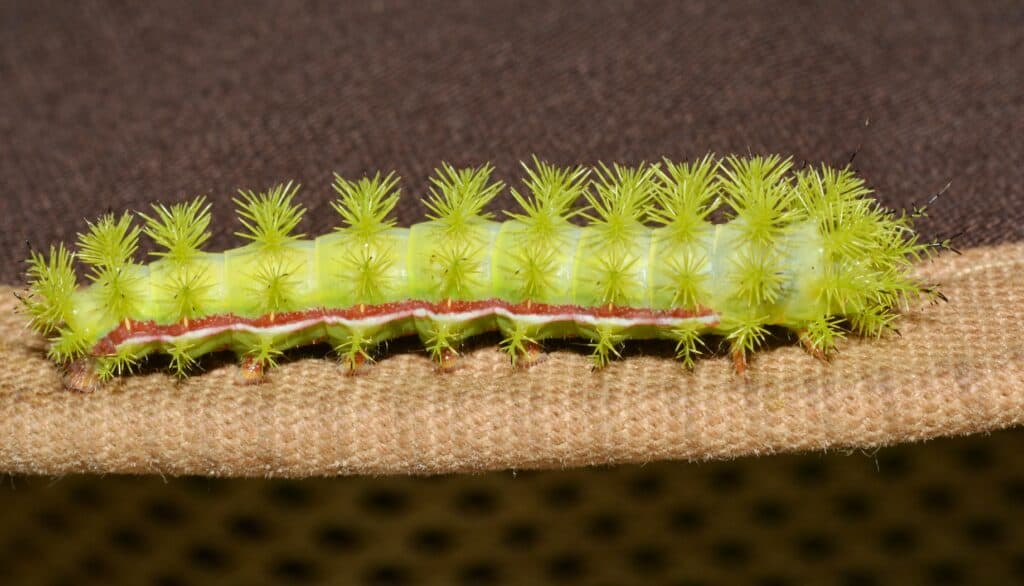
This caterpillar’s spikes pack a painful punch.
©Andy Reago & Chrissy McClarren / CC BY 2.0 – License
The Io moth caterpillar is quite a sight to see, with a light green body and bold green spikes. Red and white lines decorate either side of the body, growing about 2.4 inches when it is ready to become a moth. If you touch the spines, pain and itching happen quickly. A localized welt forms and a red flare surrounds it. When you get through the pain in a few hours, the swelling takes up to 8 hours to disappear. If you have an allergy to these caterpillars, get medical attention, especially if you also experience headaches, a fever, low blood pressure, or even muscle spasms after the sting.
These caterpillars prefer a varied diet, making them polyphagous insects. With two generations a year, finding them in Louisiana happens through the winter and summer. They primarily live in deciduous forests, suburban areas, and anywhere they can eat. Along with Louisiana, they live in the eastern side of the United States and Canada.
Dangerous: Puss Moth Caterpillar

Though they seem plump and friendly, the
puss moth
caterpillar only needs to rub against your skin for substantial pain.
©Lukas Jonaitis/Shutterstock.com
The main diet of the puss moth caterpillar consists of poplars and willows, and they like to live in sunny places. The most common areas to find in Louisiana are open woodlands, gardens, and hedges, so it is important to identify their threat properly.
This pupa gets its name from the caterpillar’s similarity to a cat, though females tend to be larger. Also known as the southern flannel moth caterpillar, it has several rows of hair that connect with venom glands, instantly releasing them through the yellow fur into your skin. If you come across this caterpillar, stay away – their sting is substantially scarier than their small length (1 inch).
Dangerous: Saddleback Caterpillar
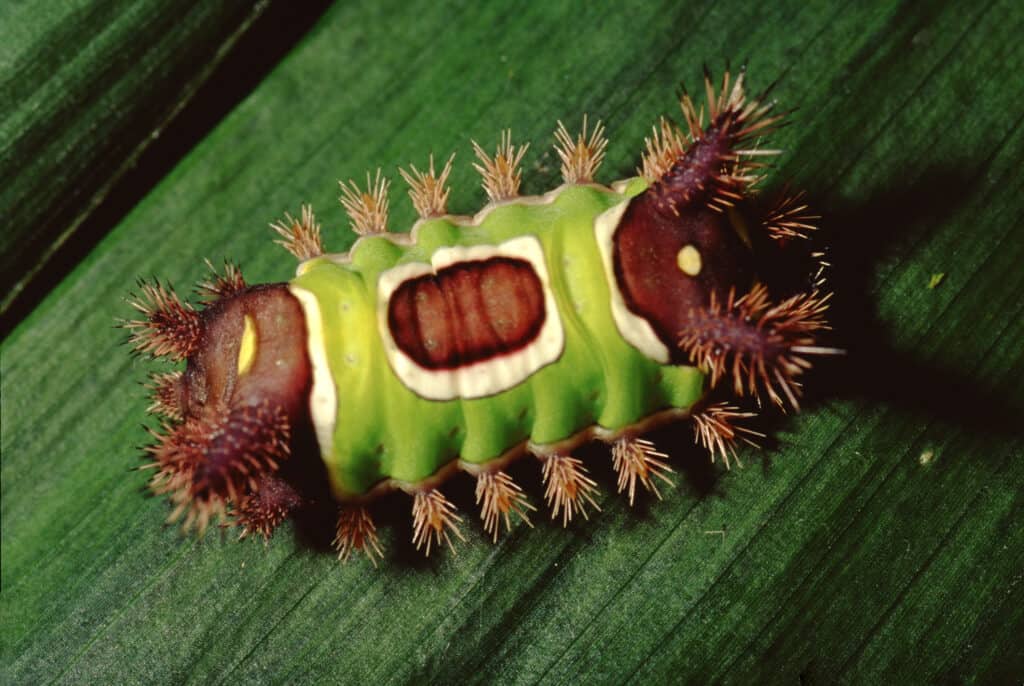
The name of the saddleback caterpillar comes from the green and brown shapes on its back.
©Liz Weber/Shutterstock.com
The brightly colored saddleback caterpillar is easy to see, with a bright green back and brown circles to decorate it boldly. Toward the head and tail, dangerous spines threaten anyone who dares to touch it, releasing a poison that causes more pain than any ordinary bee sting. Most people develop a rash or swelling with discomfort in the following hours.
Saddleback caterpillars are found along the east coast, as far west as Missouri and Texas. Since they eat sunflowers, maples, spicebush, gladiolas, and similar plants, they prefer a habitat with plenty of trees, shrubs, and even farm crops. However, their only real threat is against humans that get a little too close.
Dangerous: Eastern Tiger Swallowtail Caterpillar

The eye-like marking on this caterpillar makes it seem friendlier than it is.
©Jay Ondreicka/Shutterstock.com
The eastern tiger swallowtail caterpillar is found throughout North America except in a few states. Their highly recognizable black body with white and yellow markings makes them common among Louisiana locals. They have long tails, but their name comes from the appearance of their tails, outstretched like tiger claws.
As beautiful as these caterpillars are, they are highly toxic and like to spend their time on tulip trees, cottonwood, and other plants.
Safe Caterpillars
Safe: Luna Moth Caterpillar
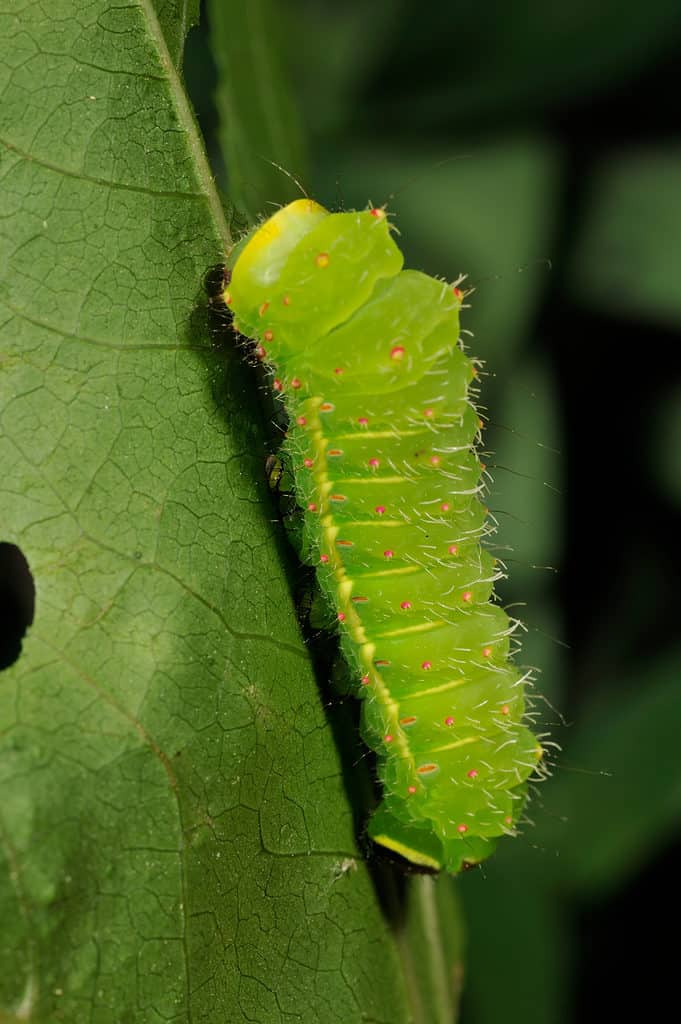
The little hairs on the Luna moth caterpillar’s body are completely harmless.
©Breck P. Kent/Shutterstock.com
Among the many dangerous moth caterpillars, there are a substantially greater number of completely harmless ones like the luna moth caterpillar. The luna moth caterpillar is one of the most common species found in Louisiana (and North America), but breeding leads to three generations being born yearly.
These caterpillars are completely harmless, but anyone who touches them needs to be gentle. They are just as fragile as they are gentle, and they decorate various trees and shrubs with a lime-green body speckled in red-orange spots and yellow lines, consuming a diet of various leaves.
Safe: Red-Headed Azalea Caterpillar
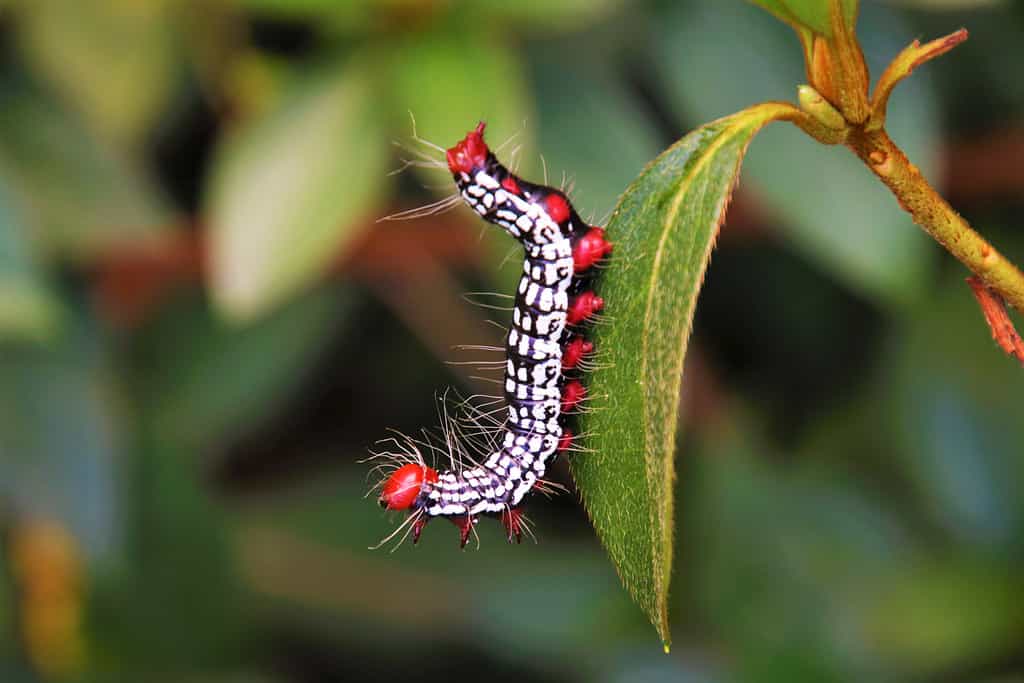
At full length, the red-headed azalea caterpillar is two inches long, and sightings commonly occur in late summer and early fall.
©Alabama Extension / Flickr – License
The red-headed azalea (Datana major) caterpillar is relatively benign, although it is damaging. This fuzzy caterpillar hatches in late summer and can strip an azalea plant. This doesn’t usually kill the azalea, but eating cramps its growth. The caterpillars have red heads and skins but don’t bite or sting. When you see these bugs, you can remove the affected branches or leaves or use a pesticide if the infestation is severe.
Safe: Forest Tent Caterpillar

The hairs of the forest tent caterpillar is only harmful if you have sensitive skin.
©jcohen9/Shutterstock.com
The forest tent (Malacosoma disstria) caterpillar is a moth larva that hatches in March. This caterpillar is fuzzy and blue with small, silver dots on its back. It goes for trees such as sweet gum, cherry, and willow. These caterpillars don’t bite, and their attack on local foliage looks ugly, but the eating doesn’t usually harm the tree. The Louisiana State University AgCenter reports that you don’t usually need to control these caterpillars but, if infestation is severe, you can spray.
Safe: Monarch Butterfly Caterpillar
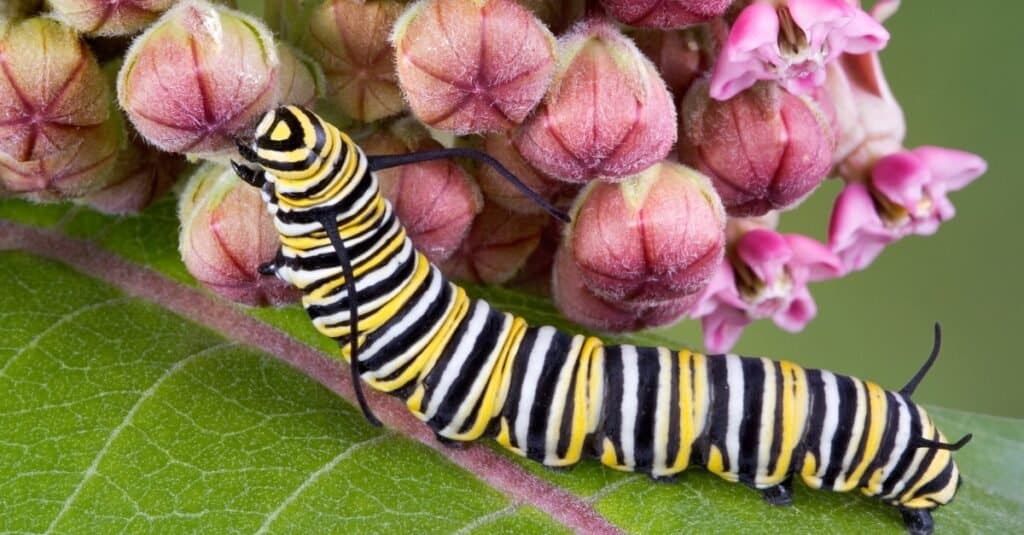
Like many caterpillars here, the monarch butterfly’s pupa stage typically occurs on or around milkweed plants.
©iStock.com/CathyKeifer
The monarch butterfly caterpillar is one of the most recognizable pupae in the world, eventually growing into the bold monarch butterfly. As a pupa, it has an orange and black body with spiky hair that makes it look fussy. Their diet primarily consists of milkweed, but they also feed on other plants. Even though the monarch caterpillar isn’t dangerous for the most part, their body metabolizes cardenolide – a toxin – from digesting milkweed, which protects it from predators.
Their adult form dines on Louisiana’s wildflowers when they finish their metamorphosis in the fall. They prefer to live along the coast, laying new eggs along milkweed plants.
Safe: Viceroy Caterpillar
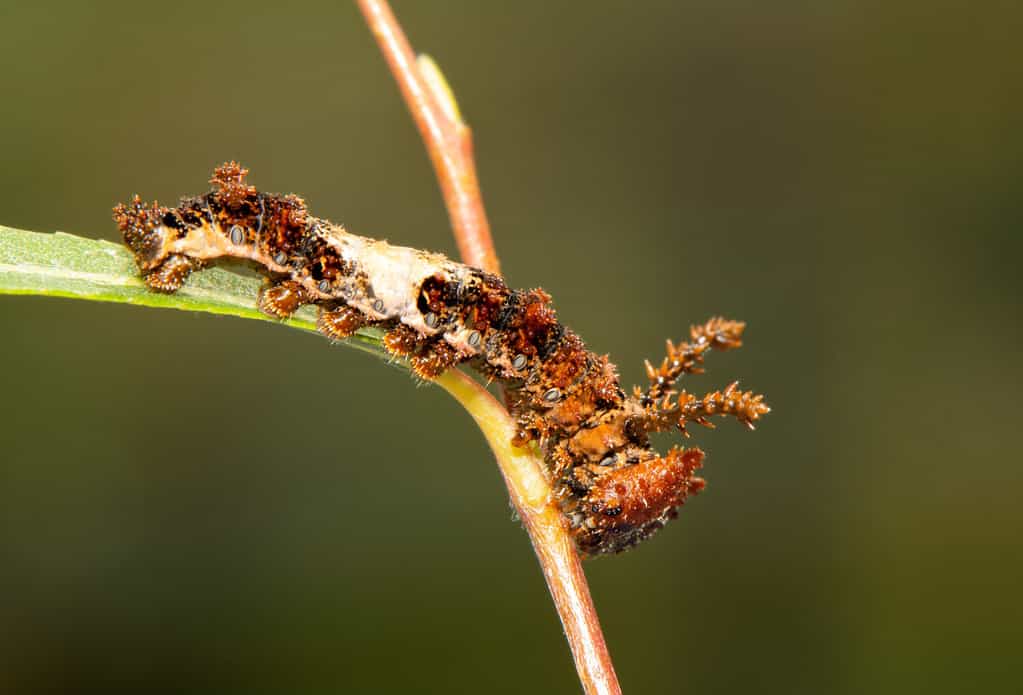
Though it doesn’t have the same sleek look as many caterpillars on this list, this insect hides well amongst the trees in woody forests.
©Sari ONeal/Shutterstock.com
Like other common caterpillars in Louisiana, the viceroy caterpillar makes its home on oak trees. There are two main color patterns – one with an orange and black pattern of bands and a similarly-colored one that poses a slight threat to others. Most people struggle to tell them apart from each other, but your best bet is to leave them alone. With poisonous hairs that line the latter, a touch on the skin is all you need to be stung. Luckily, they don’t bite, and they aren’t the aggressor in these situations.
To observe them safely, check along Louisiana’s local trees in forests and other wooded areas.
Safe: Variegated Fritillary Caterpillar
One of the easiest butterfly pupae to recognize is the variegated fritillary caterpillar. It prefers higher elevations in Louisiana, though it primarily makes a home in pastures, prairies, and other sunny areas. Since it eats milkweed and similarly deadly plants as its primary food source, its markings look just like bird droppings to stay concealed from predators like wasps, ladybugs, and lacewings. Birds also make every stage of this butterfly’s life, so they must be concealed wherever possible.
Safe: Curve-Lined Owlet Moth Caterpillar
The curve-lined owlet moth caterpillar primarily lives in gardens and house plants throughout the state, though it also lives in other areas of the United States. Instead of becoming a moth or a butterfly, it becomes a sawfly. This insect grows 5 inches long as a larva, consuming any dogbane plants and nettles. It uses silk to create a pupal case as its home, covered in leaves. They are harmless for the most part, but their bite is enough to deter someone from touching them. The odd shape of its multi-colored body makes it appear broken, but the bright legs stand out amongst the foliage.
Safe: Tobacco Hornworm
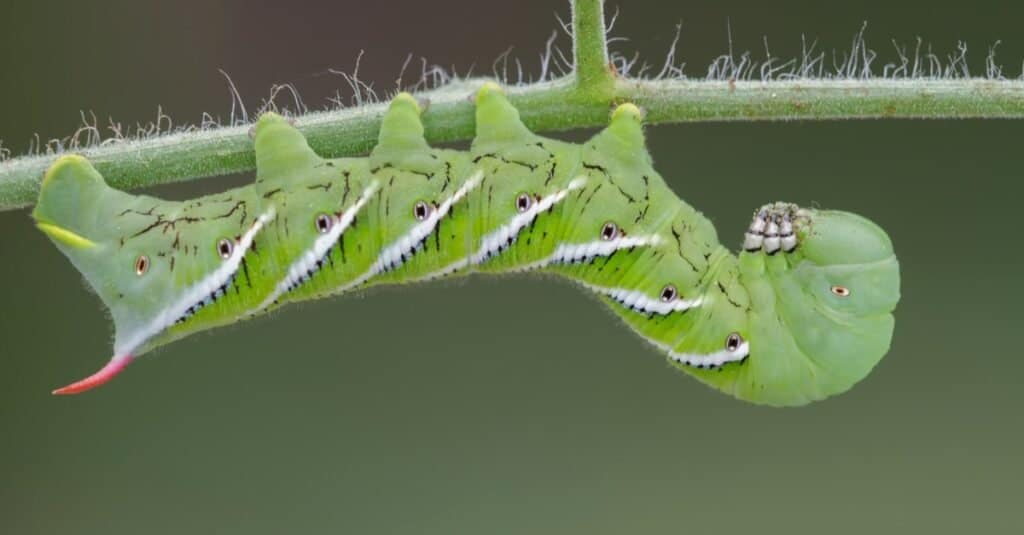
Though the tobacco hornworm puts gardens at risk, humans don’t need to worry about getting bitten or stung.
©vbalson/Shutterstock.com
The tobacco hornworm looks almost like an alien compared to the other caterpillars on this list. However, they are local to Louisiana and other southern states. In this early stage, they have a voracious appetite, eating any of the leaves and other plants they touch, including garden vegetables like green beans and tomatoes. Their bright green body easily hides amongst the stems and vines, but there’s no reason to use insecticide to eliminate it. If gentle, pick them up and place them somewhere else if necessary. Once they reach adulthood, this hornworm becomes a Carolina sphinx moth.
Safe: White-Marked Tussock Caterpillar

Named in 1797, this caterpillar lives in all areas of North America, even as far west as California.
©Satyashutter/Shutterstock.com
The white-marked tussock caterpillar is easy to spot with the tufts of fur all over its body. Like many other species, it has black and white markings, but its fur conceals most of it. These creatures live near milkweed plants. Though 70 kinds of milkweed exist in North America, the Cajun Prairie grasslands have the perfect environment for 8 of them. They also sprout up in marshes and forests.
Safe: Giant Leopard Moth Caterpillar
With black and yellow adorning its body, the giant leopard moth caterpillar is easy to spot as one of Louisiana’s most notable and bold variations. Though it looks like a much more dangerous wild cat, it isn’t threatening to humans at all. They prefer milkweeds (like many caterpillars on this list), so they must live in forests and marshes that provide the ideal home for these plants.
Safe: Black Swallowtail Caterpillar
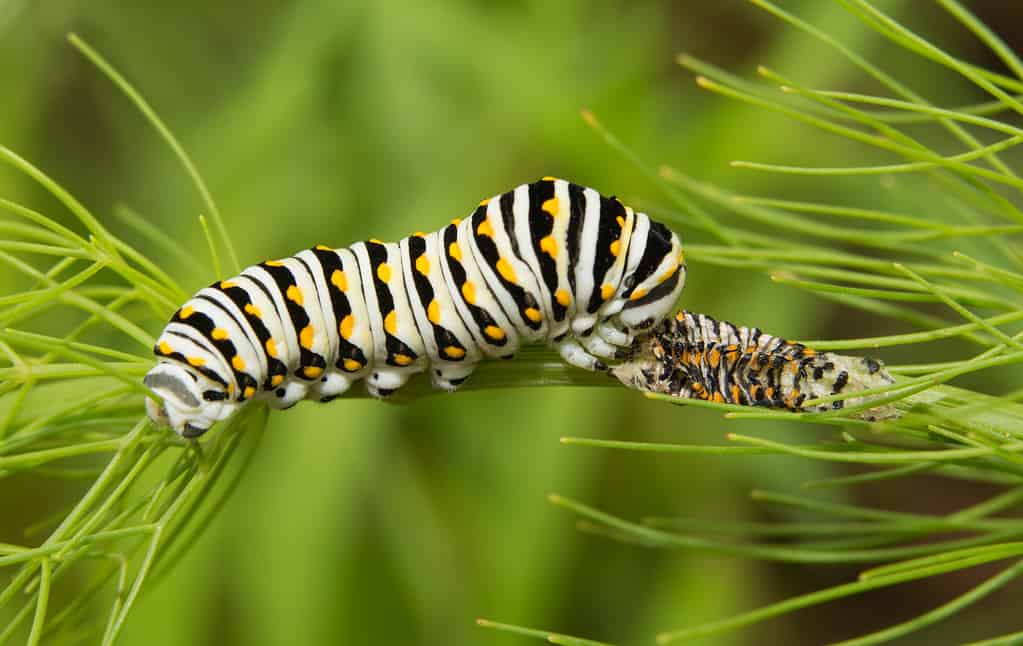
After metamorphosis, the adult butterfly’s wings are bright blue, yellow, and black.
©Sari ONeal/Shutterstock.com
Though it grows into a butterfly with starkly black wings, the black swallowtail caterpillar starts as a bright green larva with black lines and alternating dots. Its preference for parsley as its favorite food earned it another name – the parsley worm. It also eats citrus, dill, and similar herbs, which is why they are often found in Louisiana gardens in the suburbs.
Safe: Spicebush Swallowtail Caterpillar
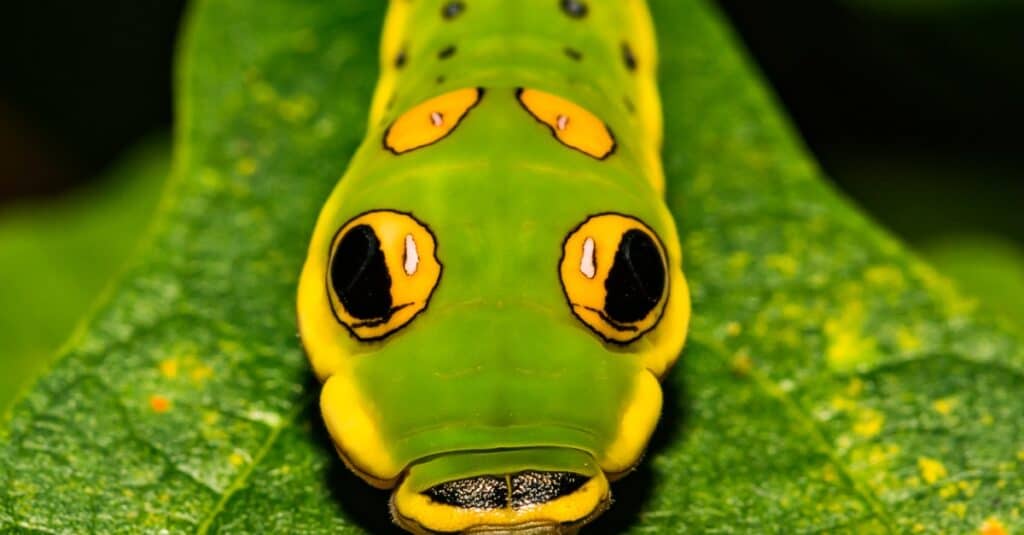
The Spicebush Swallowtail Caterpillar has two eye spots to fool predators.
©iStock.com/JasonOndreicka
At about 2 inches long, the spicebush swallowtail caterpillar features red dots along the yellow-orange head. A smooth, green body, a yellow line along either side and several black dots on the back help it blend with bright leaves. If you’re in Louisiana, the easiest time to see them is in May, June, and June due to the warm weather. Their preferred diet includes azalea flowers, blueberries, cherries, dogwood, honeysuckle, and similar plants, leading them to live in every corner of the state.
Safe: Cecropia Moth Caterpillar
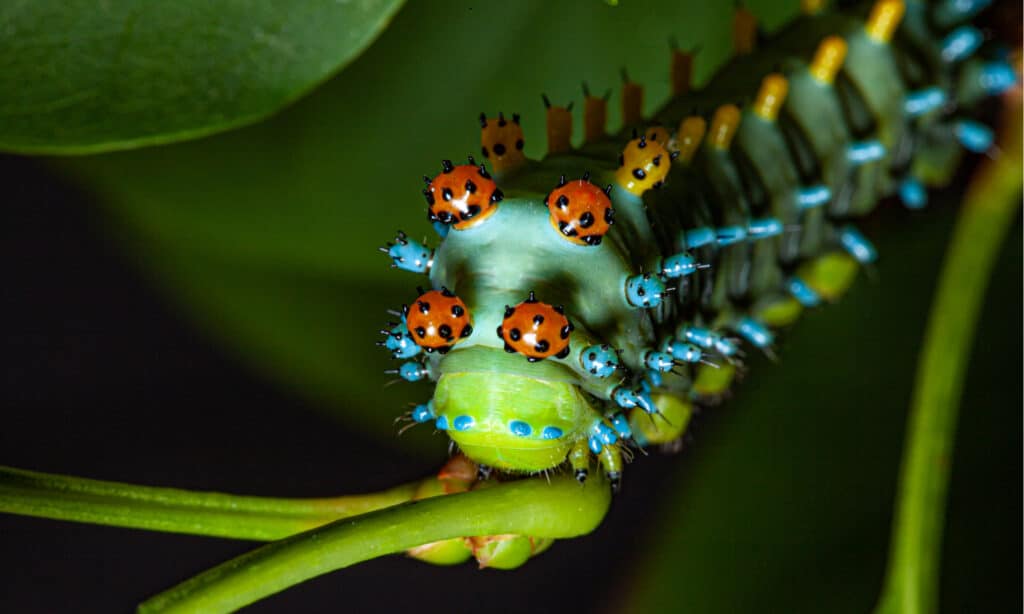
As adults, the cecropia moth has a wingspan of 5-7 inches.
©K Hanley CHDPhoto/Shutterstock.com
The cecropia moth caterpillar likes under oak trees, hickory trees, and sweet gum trees. Also known as the saddleback caterpillar, these creators have a gray or brown body, and a dark line decorates their back. The most common time to see these caterpillars is from April to May, and their notable furry texture makes them look just like woolly bears.
Safe: Monkey Slug
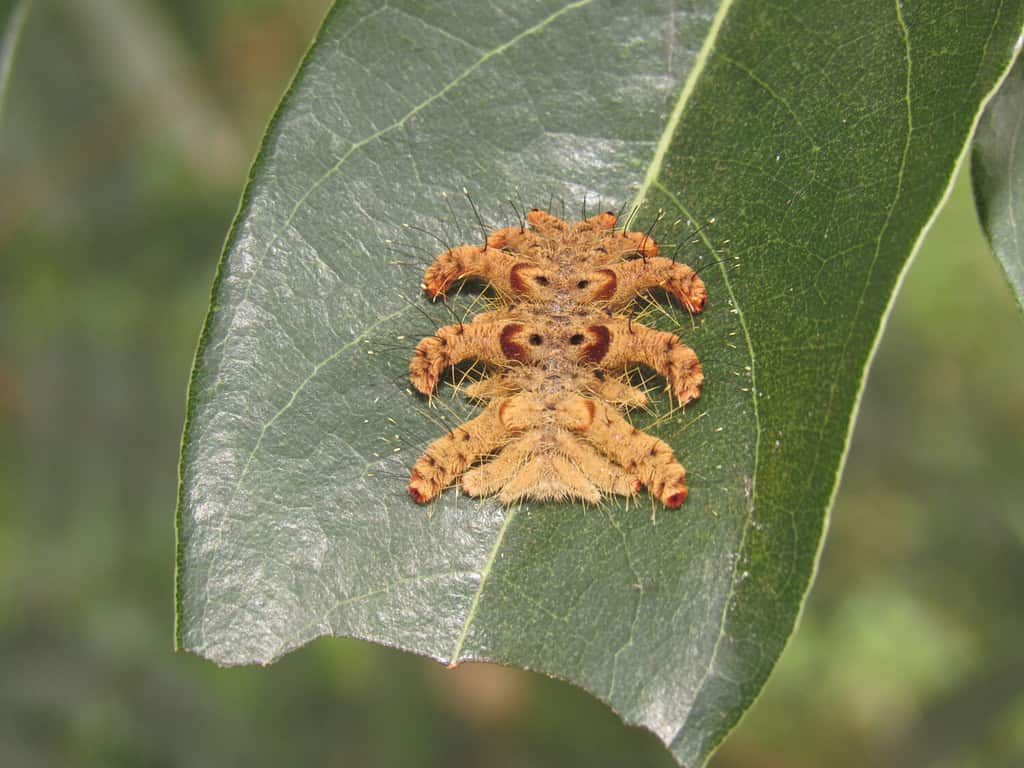
This shape might be easy to spot around the entire state when they want to be seen but don’t expect to find them.
©Fabio Ara/Shutterstock.com
The monkey slug is one of the most elusive larvae to find in Louisiana. While their presence is common, they avoid humans by finding a home in local hardwood forests. They are completely harmless, but they prefer the absence of humans whenever possible. Their diet primarily consists of saw palmetto berries, allowing them to live in wooded areas comfortably. Before it becomes a moth, this slug’s body has a starfish shape with brown skin, standing out with several yellow lines along their back.
Safe: Spotted Apatelodes Caterpillar
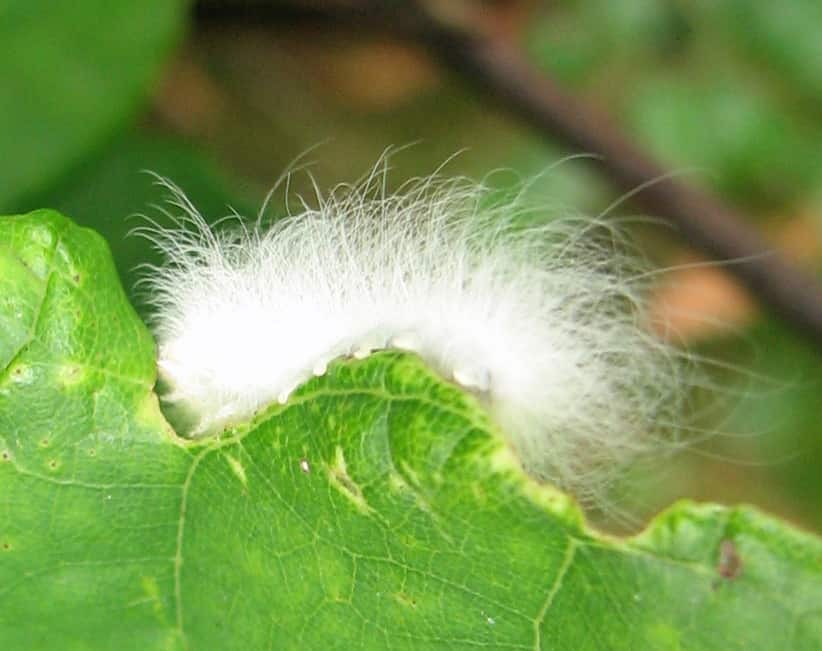
The sensational long hair coat on the spotted apatelodes caterpillar makes it easy to identify.
©Jacy Lucier / CC BY-SA 4.0 – License
Decorated in dark spots, the furry spotted apatelodes caterpillar primarily lives on cherry trees. Even if you try to remove one, they hold on tight with their hooks near their mouth, which allows them to latch onto leaves. If threatened, it simply falls, so leaving them alone is best. Their diet primarily consists of nectar and leaves from plants like honeysuckles and dogwood, so they primarily live in wooded areas with various plant life.
Safe: Flannel Moth Caterpillar
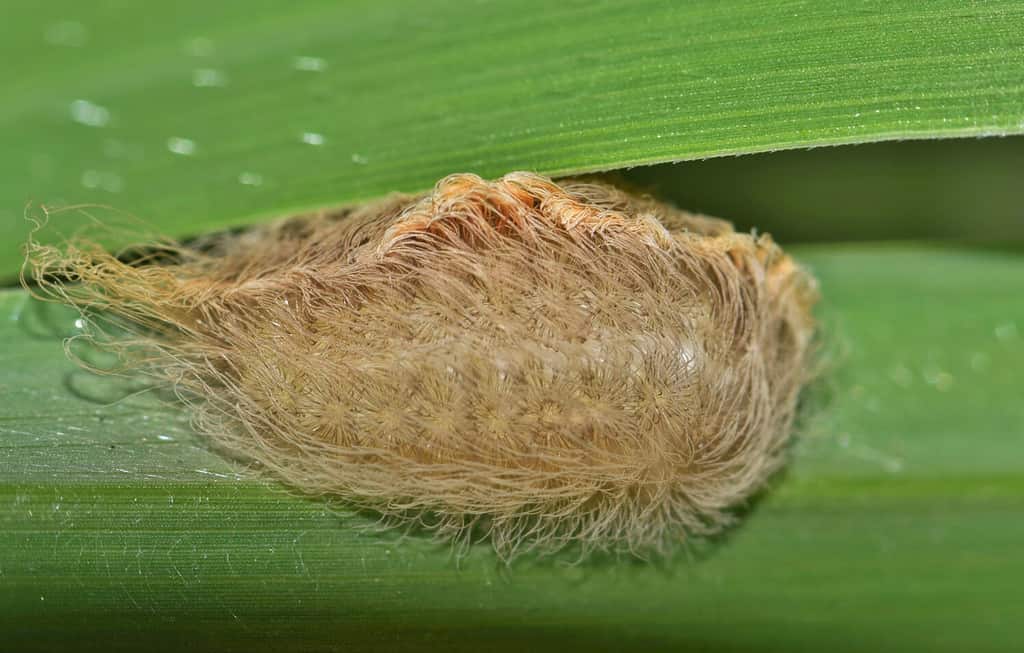
While some flannel moth caterpillars are bright yellow, some are a dull, dark shade of orange.
©Brett Hondow/Shutterstock.com
The diet of the flannel moth caterpillar has tons of variety, finding a place to live anywhere in the state. With every option available to them, they create nests near common backyard plants like birch trees, sycamore trees, and rose bushes. They blend in with plants with green, yellow, and white marks along their body. However, over 300 plant species are on the menu, so they don’t stay anywhere long.
Safe: Large Maple Spanworm
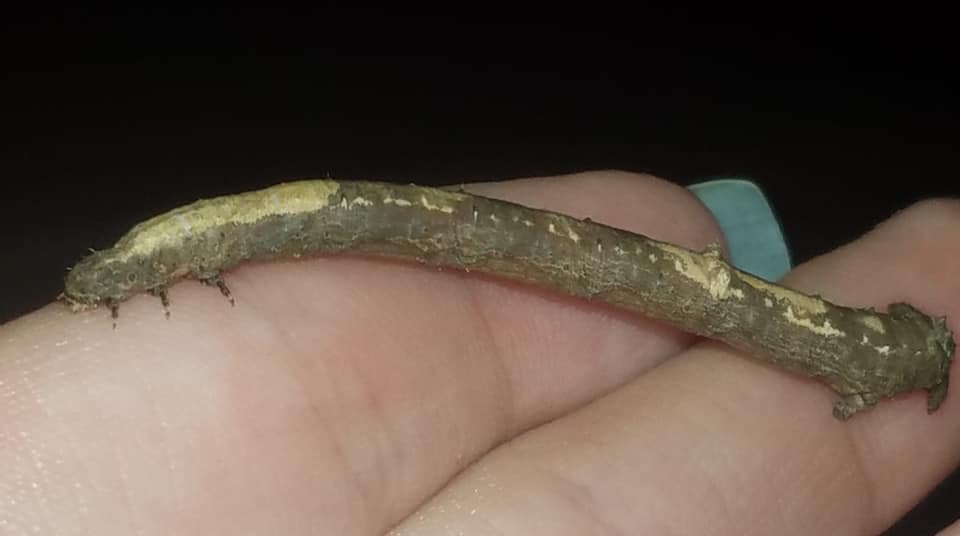
Instead of crawling like other caterpillars, the large maple spanworm moves by scooting its back legs to push ahead the front of their body.
©Andy Reago & Chrissy McClarren / Flickr – License
The large maple spanworm eats a varied diet of birch, maples, willow trees, blueberries, grass, and more, but their camouflage keeps them hidden behind tree trunks. Their bark-like appearance keeps them protected from nearby predators, getting it to adulthood without becoming a bird’s dinner. They live anywhere that conceals them, and the many forests of Louisiana are an ideal match.
Safe: American Lady Caterpillar
American lady caterpillars have a banded body with alternating sections of green and black. Each segment has two white dots, marking their spiky fur. Some of these bands have white streaks to separate them. It prefers warmer areas of the state, only coming out of its leafy nest during cloudy days and nights to eat wormwood, burdock leaves, and ironweed. Its preferred habitats include grassy lawns, sandhills, flatwoods, and areas with many weeds, though they lay eggs on leaves.
Safe: Thistle Caterpillar
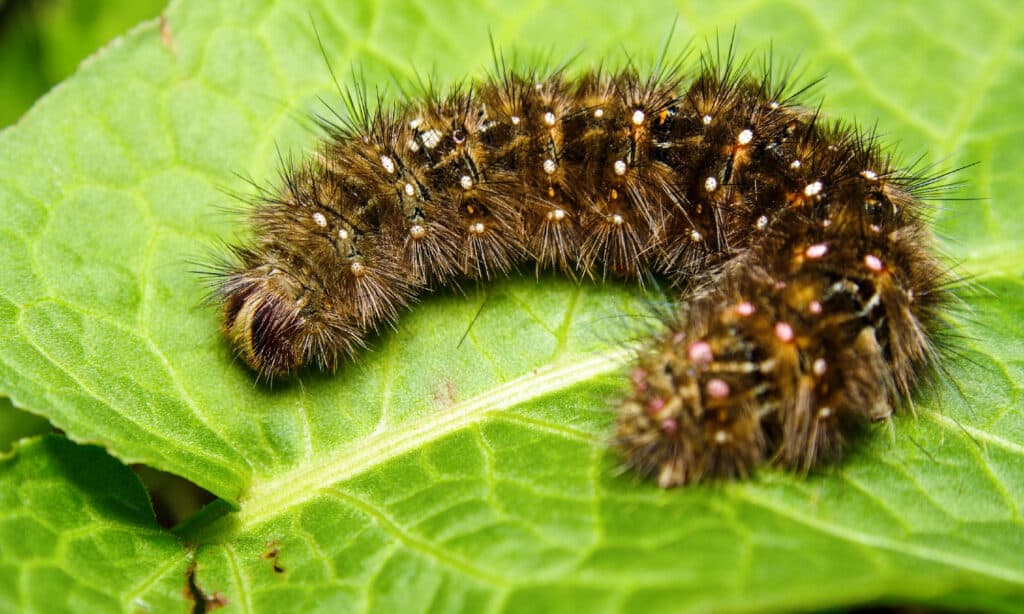
The diet of the thistle caterpillar includes hundreds of plants, including soybeans.
©iStock.com/Andrew Waugh
The thistle caterpillar, or the painted lady butterfly caterpillar, has spikes and hair along its short body, decorated in yellow, white, and black. This insect lives anywhere you see sunlight, so Louisiana fields, parks, and grassy areas have plenty of them. As a larva, they have a black body with yellow spikes extended from it, and a double line of yellow goes along its body.
Safe: Hickory Horned Devil Caterpillar

The average hickory horned devil is nearly 6 inches long!
©Matt Jeppson/Shutterstock.com
Though the name sounds threatening, the hickory-horned devil isn’t dangerous. Though it eventually becomes the bright red regal moth, it has a smooth green body with black spikes along all sides. Towards the head, the larva has red and bumpy spikes with black tips, giving it a terrifying look for potential predators, but the ends are dull and cause no harm. Its favorite foods – like hickory leaves and gum trees – lead it to live in heavily forested or lush areas.
Summary of Dangerous Caterpillar Species
| Type of Caterpillar | Name of Species |
|---|---|
| Moth | American Dagger Moth Caterpillar |
| Moth | Buck Moth Caterpillar |
| Moth | Io Moth Caterpillar |
| Moth | Puss Moth Caterpillar |
| Moth | Saddleback Caterpillar |
| Moth | Eastern Tiger Swallowtail Caterpillar |
Summary of Safe Caterpillar Species
| Type of Caterpillar | Name of Species |
|---|---|
| Moth | Luna Moth Caterpillar |
| Moth | Red-Headed Azalea Caterpillar |
| Moth | Forest Tent Caterpillar |
| Butterfly | Monarch Butterfly Caterpillar |
| Butterfly | Viceroy Caterpillar |
| Butterfly | Variegated Fritillary Caterpillar |
| Moth | Curve-Lined Owlet Moth Caterpillar |
| Moth | Tobacco Hornworm |
| Moth | White-Marked Tussock Caterpillar |
| Moth | Giant Leopard Moth Caterpillar |
| Butterfly | Black Swallowtail Caterpillar |
| Butterfly | Spicebush Swallowtail Caterpillar |
| Moth | Cecropia Moth Caterpillar |
| Moth | Monkey Slug |
| Moth | Spotted Apatelodes Caterpillar |
| Moth | Flannel Moth Caterpillar |
| Moth | Large Maple Spanworm |
| Butterfly | American Lady Caterpillar |
| Butterfly | Thistle Caterpillar |
| Moth | Hickory Horned Devil Caerpillar |
The photo featured at the top of this post is © Judy Gallagher, CC BY 2.0 – License / Original
Thank you for reading! Have some feedback for us? Contact the AZ Animals editorial team.



